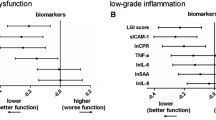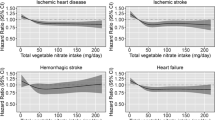Abstract
Objetives
To investigate the effects of garlic on endothelial function in patients with ischemic stroke (ISS). Design: Cross-sectional study.
Participants
125 Chinese patients with prior ISS due to athero-thrombotic disease were recruited from the outpatient clinics during July 2005 to December 2006.
Measurements
Daily allium vegetable intake (including garlic, onions, Chinese chives and shallots) was ascertained by means of a validated food frequency questionnaire for Chinese and brachial artery flow-mediated dilatation (FMD) was measured using high-resolution ultrasound in all subjects.
Results
The mean age of the study population was 65.9±11.1 years and 69% were males. Mean allium vegetable intake and garlic intake of the study population was 7.5±12.7g/day and 2.9±8.8g/day respectively. Their mean FMD was 2.6±2.3%. Daily intake of total allium vegetable (r=0.36, P<0.01) and garlic (r=0.34, P<0.01) significantly correlated with FMD. Using the median daily allium intake as cut-off (3.37g/day), patients with a low allium intake <3.37g/day was noted to have a lower FMD compared to those with a normal allium intake (2.1±2.1% versus 3.0±2.4%, P<0.05). After adjusting for confounding factors, multi-variate analysis identified that daily allium vegetable (B=0.05, 95% confidence interval: 0.02, 0.09, P<0.01) and garlic (B=0.07, 95% confidence interval: 0.02, 0.12, P<0.01) intake, but not onions, Chinese chives and shallots were independent predictors for changes in FMD in patients with ISS.
Conclusions
Daily garlic intake is an independent predictor of endothelial function in patients with ISS and may play a role in the secondary prevention of atherosclerotic events.
Similar content being viewed by others
References
Rahman K: Garlic and aging: New insights into an old remedy. Ageing Res Rev 2003;2:39–56.
Kendler BS: Garlic (allium sativum) and onion (allium cepa): A review of their relationship to cardiovascular disease. Prev Med 1987;16:670–685.
Sendl A, Elbl G, Steinke B, Redl K, Breu W, Wagner H: Comparative pharmacological investigations of allium ursinum and allium sativum. Planta Med 1992;58:1–7.
Moriguchi T, Takasugi N, Itakura Y: The effects of aged garlic extract on lipid peroxidation and the deformability of erythrocytes. J Nutr 2001;131:1016S–1019S.
Dillon SA, Burmi RS, Lowe GM, Billington D, Rahman K: Antioxidant properties of aged garlic extract: An in vitro study incorporating human low density lipoprotein. Life Sci 2003;72:1583–1594.
Gebhardt R: Multiple inhibitory effects of garlic extracts on cholesterol biosynthesis in hepatocytes. Lipids 1993;28:613–619.
Breithaupt-Grogler K, Ling M, Boudoulas H, Belz GG: Protective effect of chronic garlic intake on elastic properties of aorta in the elderly. Circulation 1997;96:2649–2655.
Das I, Khan NS, Sooranna SR: Potent activation of nitric oxide synthase by garlic: A basis for its therapeutic applications. Curr Med Res Opin 1995;13:257–263.
Yeboah J, Crouse JR, Hsu FC, Burke GL, Herrington DM: Brachial flow-mediated dilation predicts incident cardiovascular events in older adults: The cardiovascular health study. Circulation 2007;115:2390–2397.
Chen PL, Wang PY, Sheu WH, Chen YT, Ho YP, Hu HH, Hsu HY: Changes of brachial flow-mediated vasodilation in different ischemic stroke subtypes. Neurology 2006;67:1056–1058.
Santos-Garcia D, Blanco M, Serena J, Rodriguez-Yanez M, Leira R, Castillo J: Impaired brachial flow-mediated dilation is a predictor of a new-onset vascular event after stroke. Cerebrovasc Dis 2011;32:155–162.
Adams H, Adams R, Del Zoppo G, Goldstein LB: Guidelines for the early management of patients with ischemic stroke: 2005 guidelines update a scientific statement from the stroke council of the american heart association/american stroke association. Stroke 2005;36:916–923.
Lau KK, Chan YH, Yiu KH, Tam S, Li SW, Lau CP, Tse HF: Incremental predictive value of vascular assessments combined with the framingham risk score for prediction of coronary events in subjects of low-intermediate risk. Postgrad Med J 2008;84:153–157.
Chan YH, Lau KK, Yiu KH, Li SW, Chan HT, Tam S, Shu XO, Lau CP, Tse HF: Isoflavone intake in persons at high risk of cardiovascular events: Implications for vascular endothelial function and the carotid atherosclerotic burden. Am J Clin Nutr 2007;86:938–945.
Shu XO, Yang G, Jin F, Liu D, Kushi L, Wen W, Gao YT, Zheng W: Validity and reproducibility of the food frequency questionnaire used in the shanghai women’s health study. Eur J Clin Nutr 2004;58:17–23.
Thom T, Haase N, Rosamond W, Howard VJ, Rumsfeld J, Manolio T, Zheng ZJ, Flegal K, O’Donnell C, Kittner S, Lloyd-Jones D, Goff DC, Jr., Hong Y, Adams R, Friday G, Furie K, Gorelick P, Kissela B, Marler J, Meigs J, Roger V, Sidney S, Sorlie P, Steinberger J, Wasserthiel-Smoller S, Wilson M, Wolf P: Heart disease and stroke statistics—2006 update: A report from the american heart association statistics committee and stroke statistics subcommittee. Circulation 2006;113:e85–151.
Santos-Garcia D, Blanco M, Serena J, Arias S, Millan M, Rodriguez-Yanez M, Leira R, Davalos A, Castillo J: Brachial arterial flow mediated dilation in acute ischemic stroke. Eur J Neurol 2009;16:684–690.
Roquer J, Segura T, Serena J, Castillo J: Endothelial dysfunction, vascular disease and stroke: The artico study. Cerebrovasc Dis 2009;27Suppl 1:25–37.
Bertrand ME: Provision of cardiovascular protection by ace inhibitors: A review of recent trials. Curr Med Res Opin 2004;20:1559–1569.
Pretnar-Oblak J, Sabovic M, Sebestjen M, Pogacnik T, Zaletel M: Influence of atorvastatin treatment on l-arginine cerebrovascular reactivity and flow-mediated dilatation in patients with lacunar infarctions. Stroke 2006;37:2540–2545.
Karatzi K, Papamichael C, Karatzis E, Papaioannou TG, Voidonikola PT, Vamvakou GD, Lekakis J, Zampelas A: Postprandial improvement of endothelial function by red wine and olive oil antioxidants: A synergistic effect of components of the mediterranean diet. J Am Coll Nutr 2008;27:448–453.
Bondonno CP, Yang X, Croft KD, Considine MJ, Ward NC, Rich L, Puddey IB, Swinny E, Mubarak A, Hodgson JM: Flavonoid-rich apples and nitrate-rich spinach augment nitric oxide status and improve endothelial function in healthy men and women: A randomized controlled trial. Free Radic Biol Med 2012;52:95–102.
de Lorgeril M, Salen P, Martin JL, Monjaud I, Delaye J, Mamelle N: Mediterranean diet, traditional risk factors, and the rate of cardiovascular complications after myocardial infarction: Final report of the lyon diet heart study. Circulation 1999;99:779–785.
Zhou Y, Zhuang W, Hu W, Liu GJ, Wu TX, Wu XT: Consumption of large amounts of allium vegetables reduces risk for gastric cancer in a meta-analysis. Gastroenterology 2011;141:80–89.
Rahman K, Lowe GM: Garlic and cardiovascular disease: A critical review. J Nutr 2006;136:736S–740S.
Seyfi P, Mostafaie A, Mansouri K, Arshadi D, Mohammadi-Motlagh HR, Kiani A: In vitro and in vivo anti-angiogenesis effect of shallot (allium ascalonicum): A heatstable and flavonoid-rich fraction of shallot extract potently inhibits angiogenesis. Toxicol In Vitro 2010;24:1655–1661.
Grman M, Misak A, Cacanyiova S, Kristek F, Tomaskova Z, Bertova A, Ondrias K: The aqueous garlic, onion and leek extracts release nitric oxide from snitrosoglutathione and prolong relaxation of aortic rings. Gen Physiol Biophys 2011;30:396–402.
Cazzola R, Camerotto C, Cestaro B: Anti-oxidant, anti-glycant, and inhibitory activity against alpha-amylase and alpha-glucosidase of selected spices and culinary herbs. Int J Food Sci Nutr 2011;62:175–184.
Morihara N, Sumioka I, Moriguchi T, Uda N, Kyo E: Aged garlic extract enhances production of nitric oxide. Life Sci 2002;71:509–517.
Kim-Park S, Ku DD: Garlic elicits a nitric oxide-dependent relaxation and inhibits hypoxic pulmonary vasoconstriction in rats. Clin Exp Pharmacol Physiol 2000;27:780–786.
Cai H, Harrison DG: Endothelial dysfunction in cardiovascular diseases: The role of oxidant stress. Circ Res 2000;87:840–844.
Heitzer T, Yla-Herttuala S, Luoma J, Kurz S, Munzel T, Just H, Olschewski M, Drexler H: Cigarette smoking potentiates endothelial dysfunction of forearm resistance vessels in patients with hypercholesterolemia. Role of oxidized ldl. Circulation 1996;93:1346–1353.
Ide N, Lau BH: Garlic compounds minimize intracellular oxidative stress and inhibit nuclear factor-kappa b activation. J Nutr 2001;131:1020S–1026S.
Williams MJ, Sutherland WH, McCormick MP, Yeoman DJ, de Jong SA: Aged garlic extract improves endothelial function in men with coronary artery disease. Phytother Res 2005;19:314–319.
Papanas N, Maltezos E: Oral antidiabetic agents: Anti-atherosclerotic properties beyond glucose lowering? Curr Pharm Des 2009;15:3179–3192.
Author information
Authors and Affiliations
Corresponding author
Rights and permissions
About this article
Cite this article
Lau, K.K., Chan, Y.H., Wong, Y.K. et al. Garlic intake is an independent predictor of endothelial function in patients with ischemic stroke. J Nutr Health Aging 17, 600–604 (2013). https://doi.org/10.1007/s12603-013-0043-6
Received:
Accepted:
Published:
Issue Date:
DOI: https://doi.org/10.1007/s12603-013-0043-6




